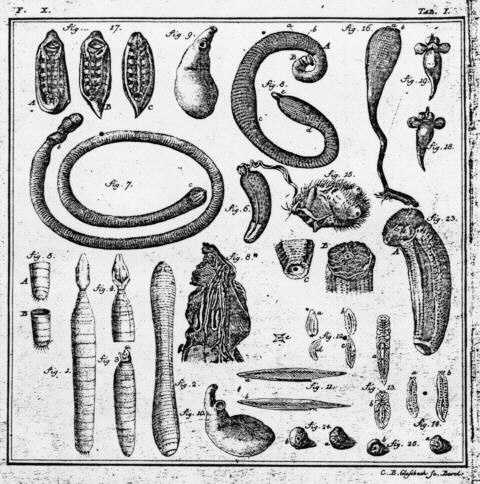
http://www2u.biglobe.ne.jp/~gen-yu/pla_classic_e.html
By Gen-yu SASAKI under supervision of Dr. M. Kawakatsu. (Contact: gen-yu@mtc.biglobe.ne.jp)
Libraries those having old planarian literature published in the 18th and 19th Centuries are very few in number, even in the Western countries. Moreover, obtaining permission to photocopy pages in old rare books is often difficult.
Dr. M. Kawakatsu has a good collection of literature on Turbellarians. Some of the images of old planarian publications taken from his collection will be open to the public as one of web articles of Gen-yu's Files. This English version is based on the Japanese language version of the web article of the same title.

TAB. I of Pallas (1774). Two planarian figures are found in the bottom-right corner (fig. 14 a and b). See enlarged figures on the next page. Dr. Kawakatsu's copy was received from the late Dr. Roman Kenk (U.S. Natl. Mus., Smithsian Institution).
"SPICILEGIA ZOOLOGICA QUIBUS NOVAE IMPRIMIS ET OBSCURAE ANIMALIUM SPECIES ICONIBUS, DESCRIPTIONIBUS ATQUE COMMENTARIIS ILLUSTRANTUR. CURA P.S.PALLAS."
FASCICULUS DECIMUS. BEROLINI, PROSTANT APUD GOTTL. AUGUST. LANGE. MDCCLXXIV.
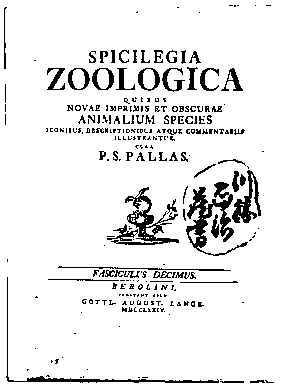 |
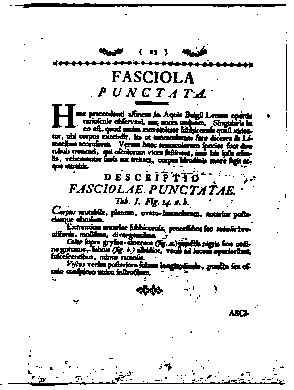 |
Pallas, 1774. Left: the title page (an elliptical seal in the middle-right corner is the Dr. Kawakatsu's stamp). Right: p.23 (a large version of this page is available).
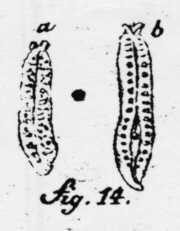

Peter Simon Pallas (1741-1811) was a German naturalist
(see Sánchez Laboratory's web page (http://planaria.neuro.utah.edu/).
His paper in 1774 (written in Latin) consists of 42 pages and 4 plates.
FASCIOLA PUNCTATA described on page 23 (see fig.; a large version is also available) is now known as Bdellocephala punctata (Pallas, 1774), an European freshwater dendrocoelid species (see figs.).
Left: Dr. Kawakatsu's (1969) water color sketch of Bdellocephala brunnea from Japan * (see http://www2u.biglobe.ne.jp/~gen-yu/plaj_list_e.html).
Middle and right: "F. punctata" (= Bd. punctata), enlarged figs. from Pallas' (1774) publication (Pl. I). Notice the body shape of these 2 Bdellocephala species from Japan and Europe.
* Kawakatsu, M. 1969. An illustrated list of Japanese freshwater planarians in color. Bull. Fuji Women's College, (7), Ser. II: 45-91 (+ pls. VII-VIII).
In his excellent book of "Planarian Regeneration", Brøondsted (1969: 4-5) cited a part of Pallas' (1774) observational note on regeneration of "F. punctata". According to Dr. Kawakatsu, Pallas (op. cit.) may be the first naturalist who observed and described the regenerative power of a freshwater planarian species. The regeneration ability in this species is rather limited.
Additionally, Brøondsted (op. cit., p.5) wrote that "The figure of Pallas, Pl. I, fig. 13a, b, seem to be Dendrocoelum lacteum....". This is problematic. The figure cited above is "Fasciola fusca" in Pallas' 1774 paper (on pp. 21-22); it may be a triclad species. It is, however, considered as a species inquirenda (cf. Kenk, 1974: 30, 47).
* Kenk, R., 1974. Index of the genera and species of the freshwater triclads (Turbellaria) of the world. Smithsonian Contr. Zool., (183): i-ii + 1-90.
"Observations on Some Interesting Phenomena in Animal Physiology, Exhibited by Several Species of Planariae. Illustrated by Coloured Figures of Living Animals. By John Graham Dalyell, ESQ."
Dalyell's book (1814) published in Edinburgh has the following constitution: i-ix + 1-150 pp. + Errata + 1 Plate ( 120 mm × 205 mm).
The book includes descriptions and observational notes on 8 "turbellarian" species. Their original names and the present taxonomic status (based upon Kenk, 1974; Kawakatsu and Mitchell, 1998) are shown in tabular form as follows:
- Planaria Flexilis (pp. 5-23, pl. figs. 1-2).
- A polyclad species.
- Planaria Nigra (pp. 23-37, pl. figs. 3-5, 15).
- Polycelis (Polycelis ) nigra (Müller, 1774) Europe and North Africa.
- Planaria Panniculata (pp. 37-41, pl. figs. 6-7).
- Polycelis (Polycelis) nigra. See above.
- Planaria Felina (pp. 42-85, pl. figs. 8-10).
- Polycelis (Ijimia) felina (Dalyell, 1814).
- Planaria Arethusa (pp. 85-114, pl. figs. 11-14).
- Crenobia alpina (Dana, 1766) Europe; Asia Minor.
- Planaria Graminea (pp. 114-127, pl. fig. 16).
- Neorhabdocoela species.
- Planaria Velox (pp. 127-133, pl. fig. 17).
- Neorhabdocoela species.
- Planaria Edinensis (pp. 133-143, pl. fig. 18).
- Probably a microturbellarian species.
Dalyell seems to be the first person who observed and described the phenomenon of planarian regeneration using modern experimental technique. On page 32 of the 1814 book, he wrote: ".... It may almost be called immortal under the edge of the knife...." (the section of "Planaria Nigra"; see an enlarged photo following).
Additionally, several other sentences cited from Dalyell's book can be read in the web article of the Sánchz Laboratory (http://planaria.neuro.utah.edu/sanchezsite/Johnson.htm).
Some of the regeneration figures of 2 European freshwater planarian species by J. R. Johnson (1825) can also be seen in that web article. Dalyell's (loc. cit.) previous work on planarian regeneration was confirmed by Johnson's new experiments.
Johnson, J. R. 1825. Further observations on Planariae. Phil. Trans. Roy. Soc. London, Part II: 247-256.
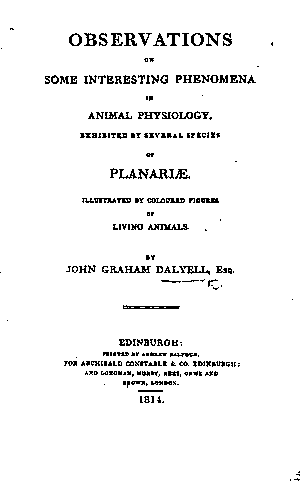 |
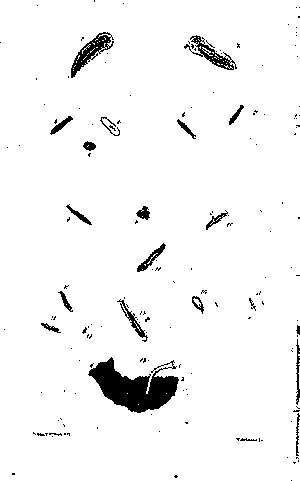 |
Dalyell's Book: Title page (left) and Plate (right). Dr. kawakatsu's copy was received from Prof. Dr. Hugh D. Jones of the University of Manchester, UK.
Observations on Some Interesting Phenomena in Animal Physiology, Exhibited by Several Species of Planariae. Illustrated by Coloured Figures of Living Animals. By John Graham Dalyell, ESQ. Edinburgh: Printed by Andrew Balfour, for Archibald Constable & Co. Edinburgh; and Longman, Hurst, Rees, Orme and Brown, London. 1814.
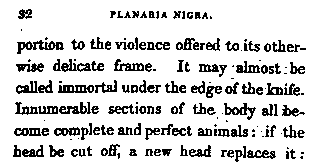 Dalyell's Book. P.32, a part.
Dalyell's Book. P.32, a part.
Apart from classical literature on planarian regeneration, some early species descriptions of this animal group are found in various taxonomic papers and books published in the second half of the 18th Century.
Carl von Linné (1705-1778) is a well-known, Swedish naturalist. The following was cited from the International Code of Zoological Nomenclature, 4th ed., published in 1999 (p. 20, Historical Background).
"Following the publication of the 10th edition of the System Naturae by Linnaeus in 1758, and his adoption in it of binominal names for species of animals, the next century saw the new system expanded and developed in different places, and in different ways for different animal groups".
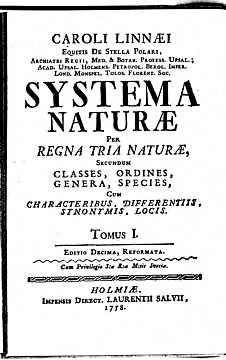 |
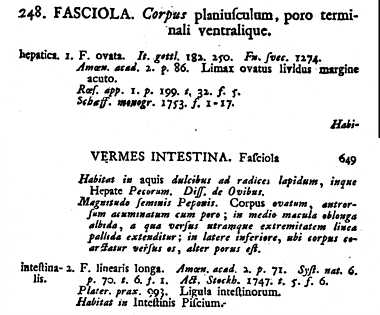 |
Linné's Systema Naturæ, ed. 10: Title page (left) and parts of pp. 648-649, FASCIOLA (right). Reproduced from the lithographic reprinted book, British Museum (Nat. Hist.), 1956. Dr. Kawakatsu's reproduced here was received from Dr. T. Kifune (Fukuoka, Japan).
Descriptions of Fasciola hepatica and F. intestina are found on pp. 648-649. The former is a fluke; the latter, species inquirenda.
According to the opinion by the late Dr. R. Kenk (1974), the item F. hepatica in another Linné's publication (1761) may include a partial note on a European freshwater planarian, Dendrocoelum lacteum (Müller, 1774). "Fasciola alpina" in Linné's 1768 book (12th ed. of the Systema Naturæ) seems to be Crenbobia alpina (Dana, 1766).
* Kenk, R., 1974. Index of the genera and species of the freshwater triclads (Turbellaria) of the world. Smithsonian Contr. Zool., (183): i-ii + 1-90.
De Hirudinis nova specie, noxa, remediisque adhibendis.
MÉLANGES DE PHILOSOPHIE ET DE MATHÉMATIQUE DE LA SOCIÉTÉ ROYALE ROYALE DE TURIN. POUR LES ANNÉES 1762-1765.
A TURIN, MDCCLXVI. DE L'IMPRIMERIE ROYALE, AVEC PERMISSION.
Joh. Petri Mariae Dana described a new species, "Hirudo alpina" in his 1766 paper (see figures). This species is undoubtedly Crenobia alpina (Dana, 1766) (several subspecies are recognized). It is a stenothermal, stream-dwelling species of freshwater planarian distributed widely in Europe and Asia Minor.
 |
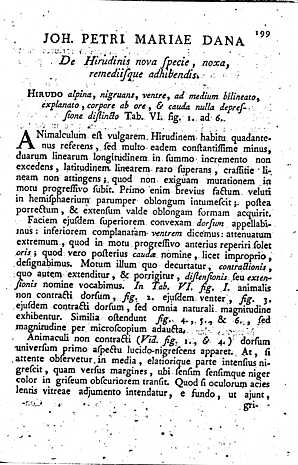 |
Dana's 1766 paper. The cover of the Italian journal that includes Dana's paper (left). The seal at the bottom-right corner is the stamp of the Library of Congress, Smithsonian Institution; the seal at the bottom-center, Dr. Kawakatsu's stamp. The first page of Dana's 1766 paper (right; p. 199).
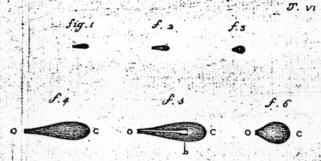
Note. 'Hirudo' means 'leech' in Latin. It is very interesting fact that 'hiru' means a 'leech' in Japanese. However there may be no linguistic relationship between these words.
The French translation of Dana's (1776) paper was published (Rozier, 1771).
(Right) A part of figures of "H. alpina" in T. VI (figs. 1-6).
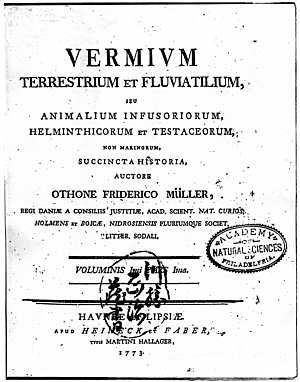
VERMIUM TERRESTRIUM ET FLUVIATILIUM, SEU ANIMALIUM INFUSORIORUM, HELMINTHICORUM ET TESTACEORUM,NON MARINORUM, SUCCINCTA HISTORIA, AUCTORE OTHONE FRIDERICO MÜLLER,
REGI DANIÆ A CONSILIIS JUSTITIÆ, ACAD. SCIENT. NAT. CURIOS. HOLMENS ET BOICÆ, NIDROSIENSIS PLURIUMQUE SOCIET. LITTER. SODALI. VOLUMINIS Imi PARS Ima. HAVBNIÆ ET LIPSIÆ. APUD HEINECK ET FABER, TYPIS MARTINI HALLAGER, 1773
HELMINTHICA. XXI.
Müller's 1773 book. The title page of the "Pars Prima". The seal at the middle-right is the stamp of the Academy of Natural Sciences of Philadelphia; the seal at the bottom-center, Dr. Kawakatsu's stamp. His copy reproduced here was received from Dr. Robert E. Ogren.
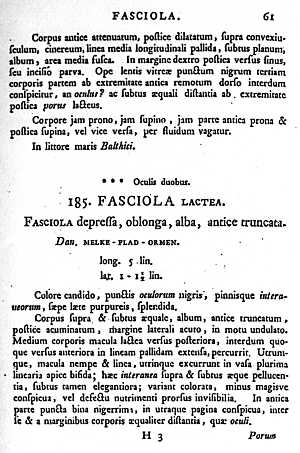 |
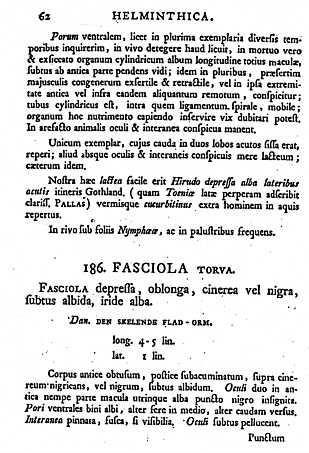 |
Müller's 1774 book. Pages 61 and 62 of the "Pars Secunda". Descriptions of FASCIOLA LACTEA (= Dendrocoelum lacteum) and FASCIOLA TORVA (= Planaria torva) can be seen.
Otto Friedrich Müller (1730-1784) is a German-Danish naturalist. His 1773-1774 book consists of 2 volumes: Pars Prima (in 1773) and Pars Secunda (in 1774). In the latter the section of the genus Fasciola contains descriptions of 32 species, of which 8 are triclad turbellarians (7 freshwater and a single land planarians, etc.). They are as follows*:
F. torva = Planaria torva (Müller, 1774); F. stagnalis = Planaria stagnalis (Müller, 1774) -- not recognizable Turbellarian; F. brunnea = Polycelis (Polycelis) nigra (Müller, 1774); F. nigra = Pol. (Pol.) nigra; F. lactea = Dendrocoelum lacteum (Müller, 1774); F. crenata = Dendrocoelum lacteum crenatum (Müller, 1774); F. tentaculata = Bdellocephala punctata (Pallas, 1774); F. terrestris = Microplana terrestris (Müller, 1774).
* Their latest Linnean names are also shown (mainly based upon the list of Kenk's 1974 paper; Kawakatsu and Mitchell, 1998).
ZOOLOGIÆ DANICÆ PRODROMUS, SEU ANIMALIUM DANIÆ ET NORVEGIÆ INDIGENARUM
CHARACTERES, NOMINA,ET SYNONYMA IMPRIMIS POPULARIUM. AUCTORE OTHONE FRIDERICO
MÜLLER,
REGI DANIÆ A CONSILIIS STATUS, ACAD. SCIENT. N. CURIOS. HOLMENS. ET BOICÆ,
HAVNIENS. NORV. BEROLINENS. ALIARUMQUE SOCIET. LITER. SODALI, ACAD. PARIS.
CORRESP. IMPENSIS AUCTORIS. HAVNIÆ, TYPIS HALLAGERIIS. M DCC.LXXVI.
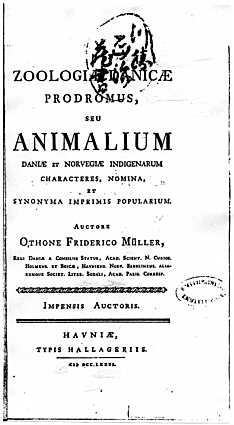 |
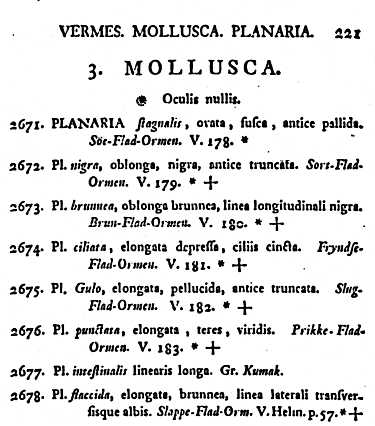 |
Müller's 1776 book. The title page (left). The seal at the middle-right is the stamp of the Smithsonian Institution. A part of page 221 showing descriptions of several species of the genus Planaria. Dr. Kawakatsu's copy reproduced here was received from the late Dr. R. Kenk.
The original description of the genus Planaria Müller, 1776, was given in this paper (on p. 221). Namely, the turbellarian species were separated from the genus Hirudo Linné, 1758. A total of 36 species were listed under Müller's new genus Planaria (Nos. 2671-2706, on pp. 221-223).
The genus Planaria now including some 55 or more species and subspecies in Kenk's (1974) list. However, it includes many species inquirendae.
The compiler (Sasaki) wishes to express his gratitude to Dr. Masaharu Kawakatsu (Sapporo, Japan) for suggesting this web article as well as for his constant guidance in the course of this work. Sasaki is also indebted to Dr. Robert W. Mitchell (Bandera, Texas, U.S.A.) for his invaluable advice and careful corrections of the final English draft of this article.
See also Index of Planarian pages in "Gen-yu's Files"